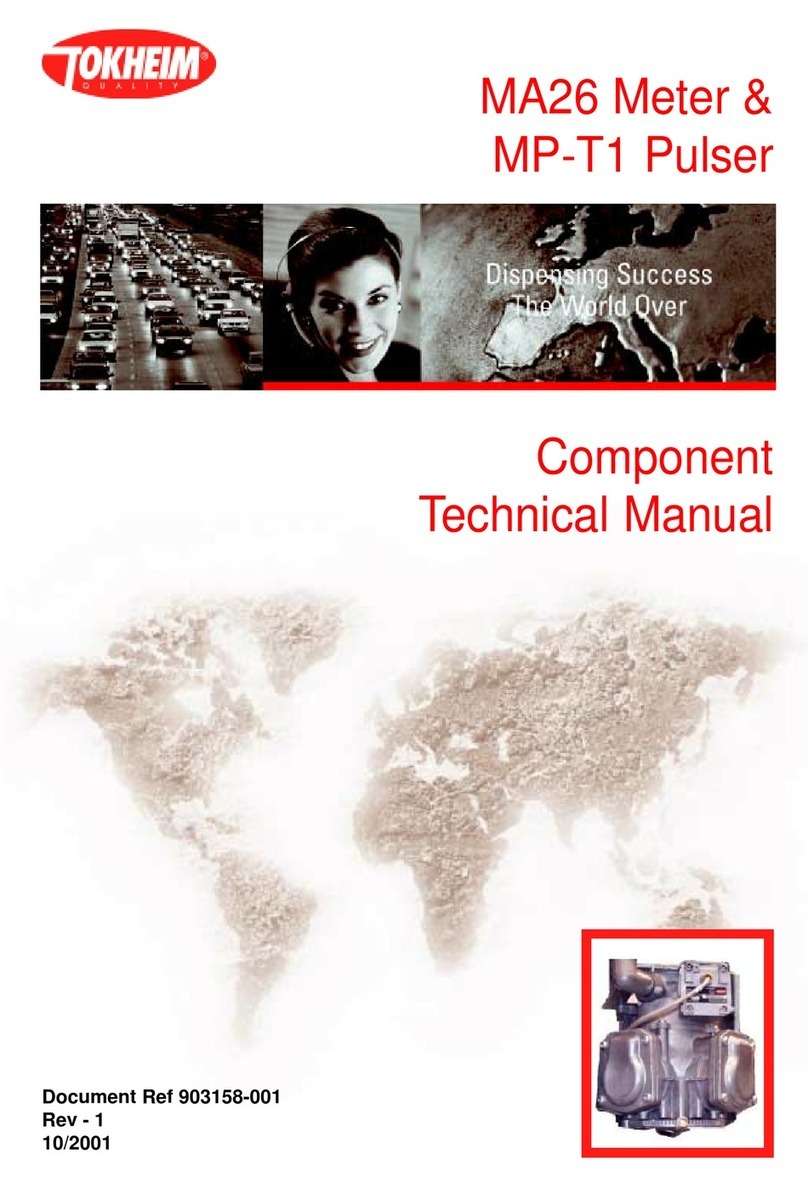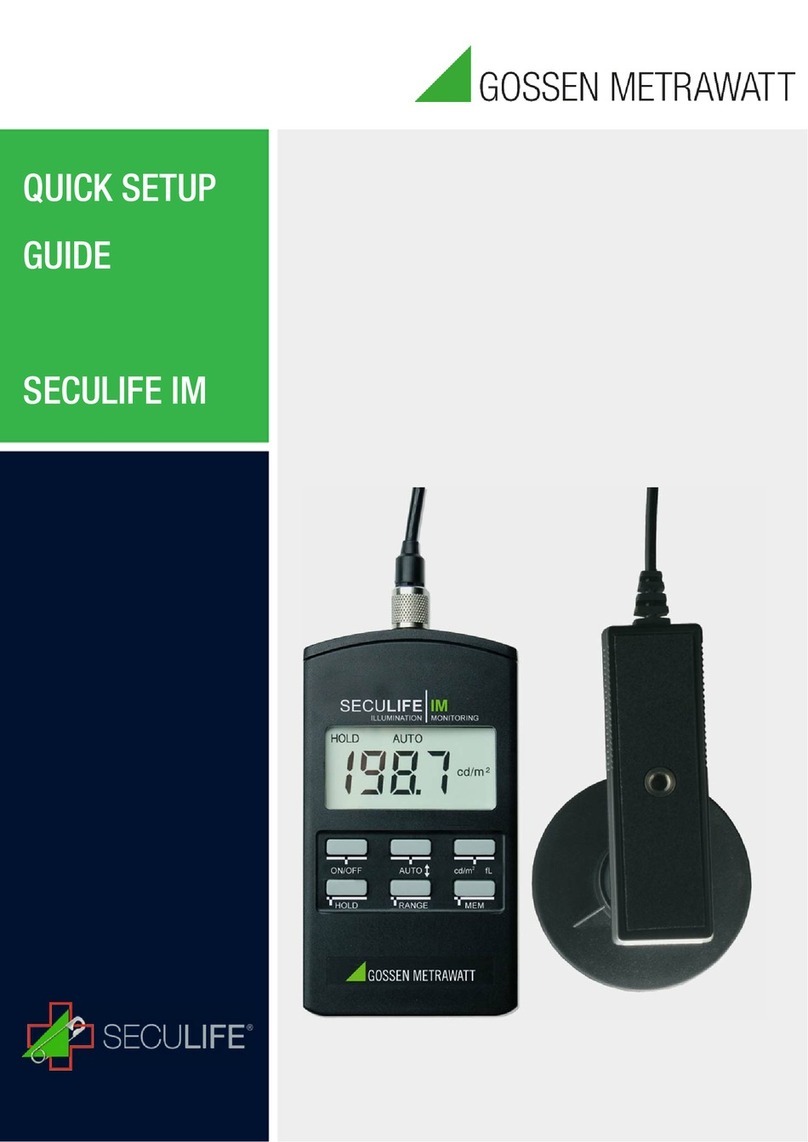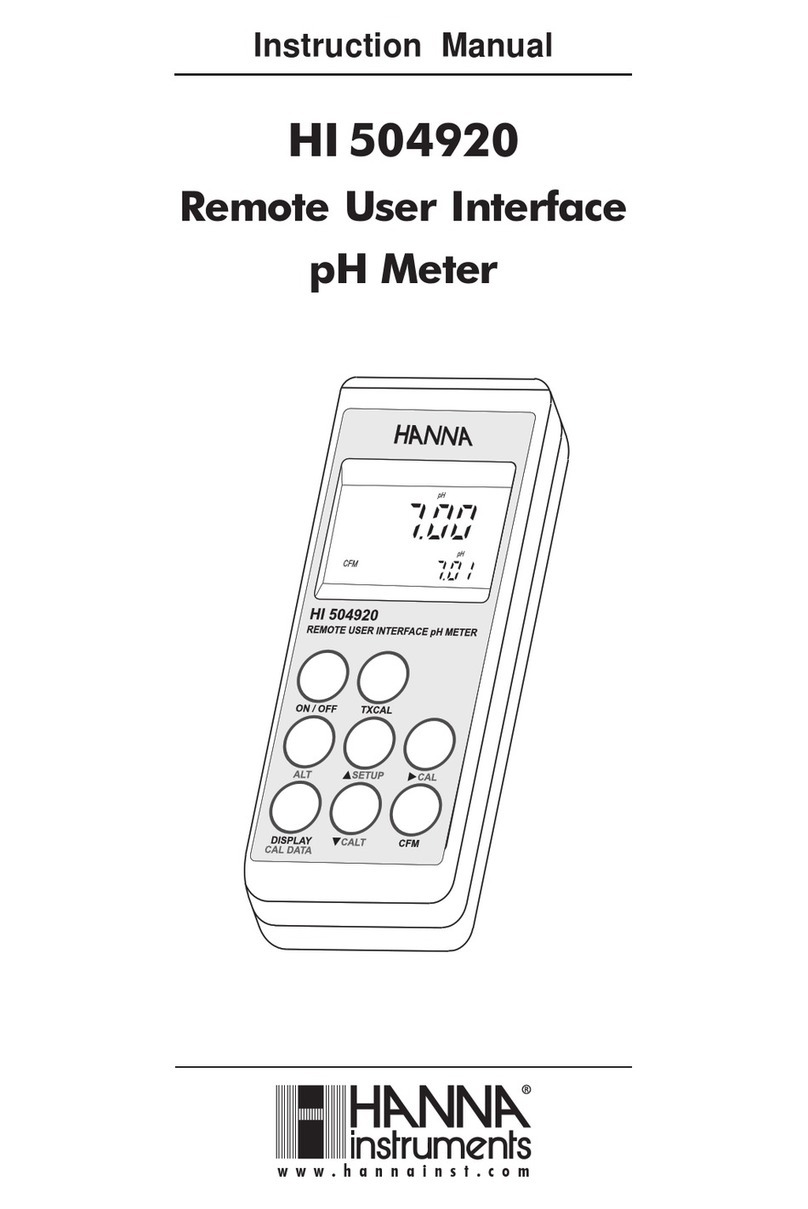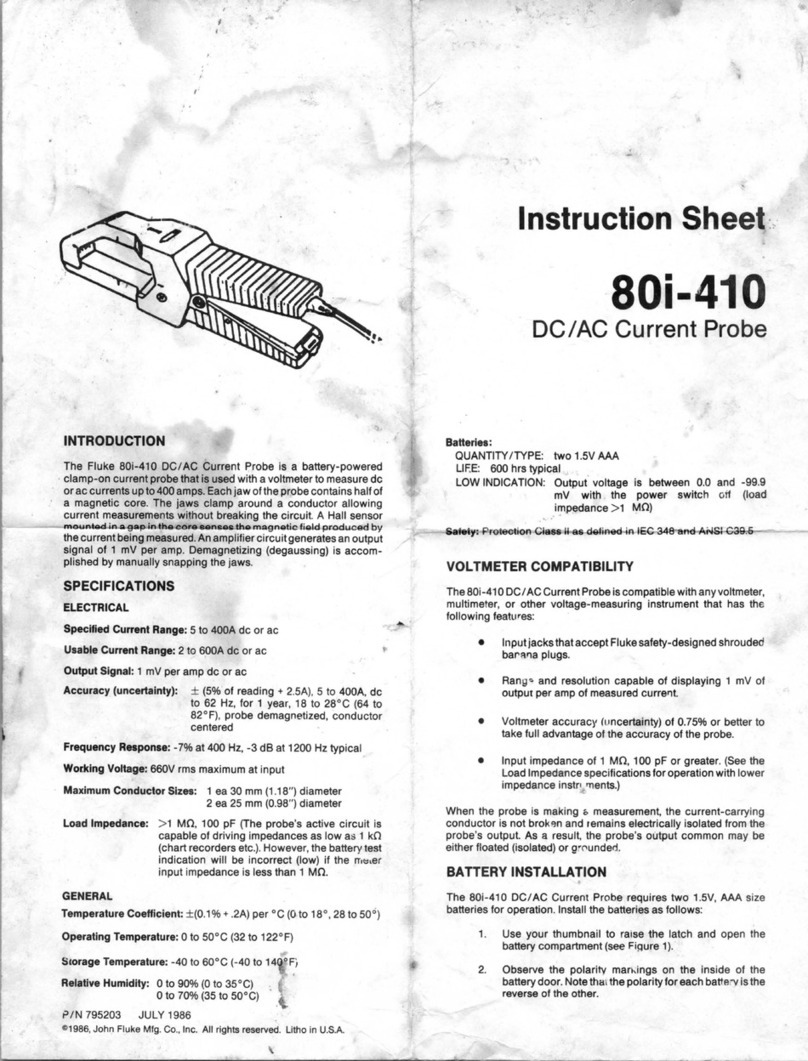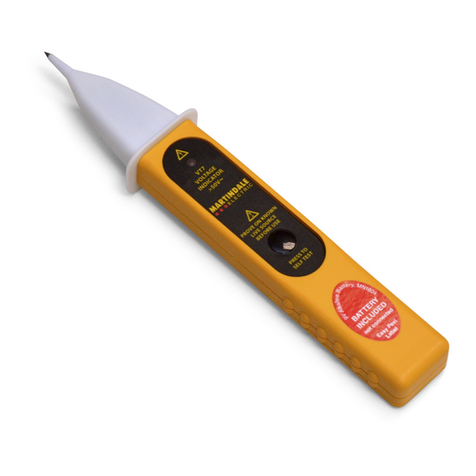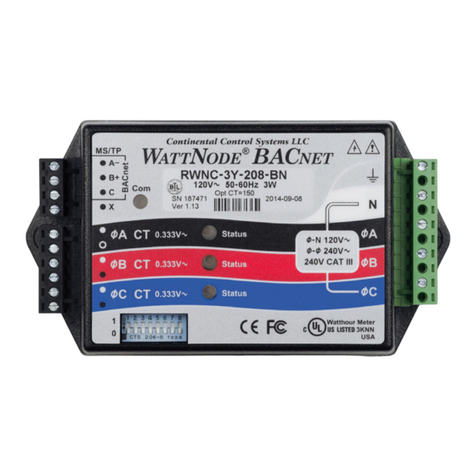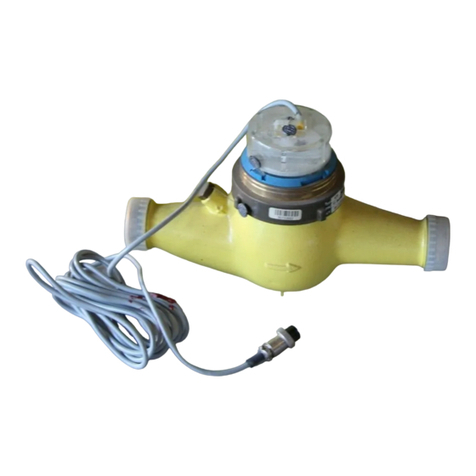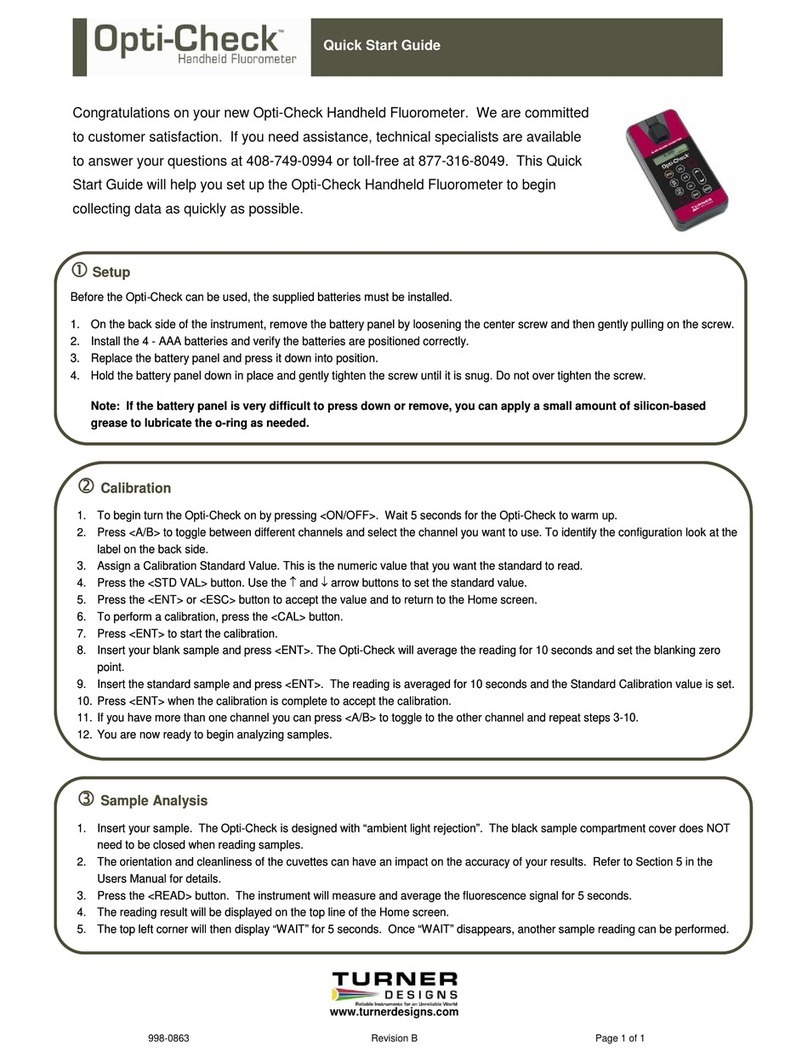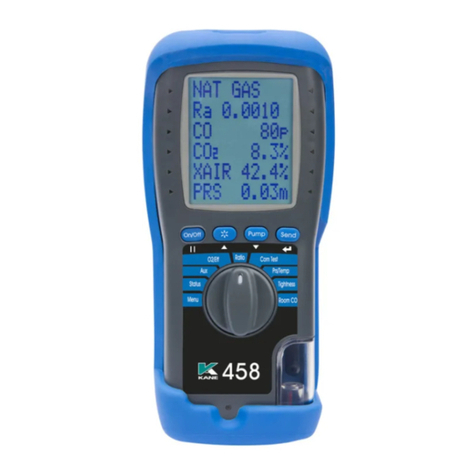Flowmasonic WUF100 CF Series User manual


Welcome to use the new generation ultrasonic flow meter made of our patented technology.
WUF 100 CF Series Ultrasonic the transit- time principle to measure the
velocity of relatively
clean liquids in full pipes.
The purpose of this guide is to provide installation procedures and basic operating instructions
for
WUF 100 CF Series Ultrasonic Flow/Heat Meters.
1.
Products Categories
1.1 Composition of Ultrasonic flow meter
Ultrasonic Flow meter = Converter + Transducer + Bracket
1.2 Types of Converters
Items
Separated Mount
Wall mount
WUF100 CF
Fix Mount
WUF100 IR
1.3 Types of Flow/Temperature Transducers
Flow Transducer
Picture
Model
Measuring
Range
Temperature
Clamp On
TS -2 (Small)
DN 25-80
-30~160°C
TM-1 (Medium)
DN 100-200
TL -1 (Large)
DN 250-6000
Inline
Standard
DN 15 -1000
- 30~160°C
2.
Check Components
1. Please check you have all the components in the order.
2. All codes on the converter and transducers should be matched. They are used in sets.
Transducer Codes
Transducer Codes Or Converter

3. Measuring Diagrams
3.1 Separated Mounting
Clamp On
Inline
3.2 Fixed Mounting
Clamp On Inline
4.
Converter Installation and Wiring Diagram
4.1 Separated Mounting
·
WUF100 CF Dimention

·
Wall mounting: Fix the converter with 4 6 expansion bolts or normal nails
· DIN-rail mounting by using rail fixing clamps
·
DIN-rail mounting by using PCB bracket
Converter of WUF100 CF can be installed on the wall or in distribution box and
explosion proof box
· Converter of WUF100 CF can be installed on the wall or in distribution box and
explosion proof box
·

· WUF 100 CF Wiring Diagram
Thickness: 75mm Thickness: 165mm
Wall mounng:Fix the onverter Explosion-proof grade: DⅡBT5
with 4 Φ6 expansion bolts. Fix the converter with 4 Φ8 expansion
bolts.
4.2 Fix mounting

The converter is generally
installed on the pipeline, sometimes installed on the wall of a well
to avoid water immersion.
· WUF-100 IR Wiring Diagram
Open the back cover and complete the wiring. To avoid leaking, please tighten the
water joint and screws of the back cover after wiring. Be sure not to open the front
cover.
5.
Display and Operation
Display is 2×20 characters LCD with backlight, available to set backlight time and
contrast.
·
16-key Keyboard

Separated Mounting
-
And are used for inputting numbers or menu numbers.
is used for back left or delete the left character.
and
are used for entering into the last and next menu. Also can be used as ±
sign when inputting numbers.
is used for accessing the menu. Press this key first, then type the number keys to
enter into the matched menu.
is the ENTER key, used for confirming the contents you input or choose.
: used for entering into menus.
: used for menu up or choosing 0-9, +, -
: used for menu down or moving the cursor to next
:
0 9 .
MENU
ENT
·key Keyboard
The user interface of this flow meter comprises about 100 different menu windows that are
numbered by M00, M01, M02 … M99.
Method to enter Menu: Press MENU first, and follow the two- digit number keys. Take M35 as an
example, the correct key sequence is MENU 3 5
To move between the adjacent menus, press ▲/+ and
▼
/-
for 16-key keyboard; press ▲
and
►
for
4-key keyboard.
5.3
Menu Details
Menu No.
Details
M00
Display flow rate and NET totalizer. Unit selction in M30~M32
M01
Display flow rate and velocity. Unit selection in M30~M32
M02
Display flow rate and POS(Positive) totalizer. Unit selction in M30~M32
M03
Display flow rate and NEG(Negative) totalizer. Unit selction in M30~M32
M04
Display date and time , flow rate
M05
Display heat flow rate and total heat. Unit selction in M84~M88
M06
Display temperatures, intel T1, outlet T2
M07
Display analog inputs, AI3/AI4
M08
Display system error codes. ‘R’ stands for normal

*M12
Input pipe wall thickness.
*M13
Input inner diameter
*M14
Select pipe material
M15
Input sound velocity of the pipe material
M16
Select lining material
M17
Input sound velocity of the lining material
M18
Input the lining thickness
M19
Input the absolute roughness of pipe inner wall
*M20
Select the liquid type
M21
Input sound velocity of the liquid
M22
Input viscosity of the liquid
M09
Display today’s total NET flow
M10
Input outer perimeter
*M11 Input outer diameter. Available range is 0 to 18000mm
*M23
Select the transducer type. Over 20 types can be selected
*M24
Selec the mounting method of transducer
*M25
Display the transducer mounting distance
*M26
0 Use RAM Setting : A switch for the parameters in flash memory will be loaded
when power is turned on. The default option is that the parameters will be load
If this switch is not turned on, the system will try to use the parameters are ok,
otherwise the system will load the parameters in flash memory.
1 Solidity setting: Function to store the current parameters into the flash memory
, so that these parameters will be solidified and will be loaded as the default
parameters every time when power is turned on.
M27
To save the installation point parameter.
M28
Maintain the last good value when poor signal condition occurs. YES is the
default setup.
M29
Setup a signal strength as empty pipe. For example input 65, it means the pipe is
treated as
empty pipe when the signal is less than 65, and the flow rate display is 0.
M30
Select metric or british system unit.
M31
Select flow rate unit.
M32
Select totalizer flow unit.
M33
Select totalizer multiple factor.
The multiplying factor ranges from 0.001 to 10000. Factory default is 1
M34
Turn on or turn o ffthe NET totalizer
M35
Turn on or turn o ffthe POS (positive) totalizer
M36
Turn on or turn off
the NEG(negative) totalizer
M37
Restore factory settings. Totalizer reset.
M38
Manual totalizer used for easier calibration. Press a key to start and press a key to stop
the
manual totalizer.
M39
Language selection. there are Chinese+English+Italian or English+Italian+Turkish
*M40
Damping factor. The damping factor ranges from 0 to 999 seconds.
0 means there is no damping. Factory default is 10 seconds
*M41
Cut-o fflow flow rate (or zero flow rate) to avoid invalid accumulation.

M45
Flow rate scale factor. The default value is ‘1’.
Keep this value as ‘1’, when no calibration has been made.
M46
Networks address identification number. Any integer can be entered except 13(0DH,
carriage return), 10 (0AH, line feeding), 42 (2AH), 38, 65535.
Every
set of the instrument in a network environment should have a unique IDN.
Please
refer to the chapter for communication.
M42
Zero calibration/Zero point setup. Make sure the liquid in the pipe is not running
while
doing the setup.
M43 Clear the zero point value, and restore original value.
M44 Manual Zero point . Set up a flow bias. Generally this value should be 0.
M47
System locker to avoid modification of the system parameters.
If password is forgotten, you could send a command ‘LOCK0’ to the serial input to
unlock. Or you can write 0 to REGISTER49 -50 under MODBUS protocol.
M48 Entry to linearity correcting data inputs. By using of this function, the non- linearity of
flow meter will be corrected. Correcting data shall be obtained by careful calibration.
M49 Displays the input contents for the serial port.
By checking the displays, you can know if the communication is ok.
M50
Switches for the built-in data logger. There are as many as 22 different items can be
chosen. To turn this function, select ‘YES’ the system will ask for selecting the items.
M51 Time set for timing output.(data logger or printer)
M52
Data logging direction control.
(1) If ‘Send to RS485’ is selected, all the data produced by the data logger will be
transmitted out through the RS-232/RS485 interface
(2) If ‘To the internal serial BUS is selected, the data will be transmitted to the
internal
serial bus which allows a thermal printer, or a 4-20mA analog output module, to be
connected to it.
M53
Display analog inputs, AI5, current value and its corresponding temperature or
pressure or
liquid level value.
M54
Pulse width setup for the OCT (OCT1) output. Range from 6 mS to 1000 mS
M55
Select analog output (4-20mA current loop, or CL) mode.
M56
Set the value which corresponds to 4mA or 0mA output current (4mA or 0mA is
determined by the setting in M55)
M57
Set the value which corresponds to 20mA output current
M58
Current loop verification
Check if the current loop is calibrated correctly.
M59
Display the present output current of current loop circuit.
M60
Setup system date and time. Press ENT for modification.
M61
Display Version information and Electronic Serial Number (ESN) that is unique for
each
flow meter.
M62
RS-232/RS485 setup. All the devices connected
with flow meter should have matched
serial configuration.
M63
Select communication protocol.
Factory default is ‘MODBUS ASCII. this is a mode for MODBUS- ASCII, Meter
BUS,
Fuji Extended Protocol, Huizhong’s various protocols.
If you are going using MODBUS -RTU you have to select ‘MODBUS_RTU’.
M64
AI3 value range.
Used to enter temperature/pressure values that are corresponding to 4mA and 20mA
input
current. The display values have no unit, so that they can present any physical
parameter.

M65
AI4 value range.
Used to enter temperature/pressure values that are corresponding to 4mA and 20mA
input current.
M66 AI5 value range.
Used to enter temperature/pressure values that are corresponding to 4mA and 20mA
input current.
M67
Setup the frequency range (lower and upper limit) for the frequency output function.
Valid range is 0Hz-9999Hz. Factory default value is 0- 1000 Hz.
M68
Setup the minimum flow rate value which corresponds to the lower frequency limit of
the frequency output.
M69
Setup the maximum flow
Rate value that corresponds to the upper frequency limit of
the frequency output.
M70
LCD display backlight control.
M71
LCD contrast control.
M72
Working timer. It can be cleared by pressing ENT key, and then select YES.
M73
Window to setup the lower limit of flow rate for Alarm#1.
When the flow rate is below the set value, Alarm#1 equals ‘on’
M74
Window to setup the upper limit of flow rate for Alarm#1.
When the flow rate is above the set value, Alarm#1 equals ‘on’
There are two alarms in the flow meter, and every alarm can be pointed to alarm
output devices such as the BUZZER or OCT output or RELAY output. For example, if
you want the Alarm#1 is to output by the OCT circuit, you need to set M78 at
selection item 6.
M75
Window to setup the lower limit of flow rate for Alarm#2.
M76
Window to setup the upper limit of flow rate for Alarm#2.
M77
Buzzer setup.
If a proper input source is selected, the buzzer will beep when the trigger event occurs.
M78
OCT (Open Collect Transistor Output)/OCT1 setup
By selecting a proper input source, the OCT circuit will close when the trigger event
occurs.
M79
Relay or OCT2 setup
By selecting a proper input source, the RELAY will close when the trigger event
occurs
M80
Window for selecting the trig signal for the built - in batch controller. Available trig
sources:
0. Key input (press ENT key to start the batch controller)
1. Serial port
2. AI3 rising edge (when AI3 receives 2mA or more current)
3. AI3 falling edge (when AI3 stop receiving 2mA or more current)
4. AI4 rising edge (when AI3 receives 2mA or more current)
5. AI4 falling edge (when AI3 stop receiving 2mA or more current)
6. AI5 rising edge (when AI3 receives 2mA or more current)
7. AI5 falling edge (when AI3 stop receiving 2mA or more current)
8.Timer periodically (define the start time and interval time in M51)
9.Timer daily (define the start time and interval time in M51)
For the input analog current signal, 0 mA indicates “0”, 4mA or more indicates ‘1’.
By selecting item #8, the batch totalizer can
be started periodically by the internal
timer
located at Menu51. When the batch totalizer is full, a signal which indicate the batch is
full can be direct to either the OCT or the RELAY terminals to stop the pump or other
devices.
By selecting item #9, the batch totalizer could act as totalizer witch runs for only a
period of the day so that a alarm signal could be produced if the total flow during that
time period is over a certain amount of. For example, if you want a alarm signal which
stand for the total flow is over 100 cubic meters during the period of every day from
20:00 to 06:00, setups is like
M51 start time =20:00:00
M51 interval =10:00:00
M51 log times =9999 (means always)
M80 select item #9
M81 input 100 (Unit is defined in M30,M31,M32)

M81
The built-in batch controller
Set the flow batch value(dose)
The internal output of the batch controller can be directed either to the OCT or the
RELAY output circuits.
M81 and M80 should be used together to configure the batch controller.
Note: Because the measuring period is 500mS, the flow for every dos should be
keeping at 60 second long to get a 1% dose accuracy
M82
View the daily, monthly and yearly flow totalizer and thermal energy totalizer value.
The totalizer values and errors for the last 64 days, 32 last 32 months and last 2 years
are
stored in the RAM memory, To view them, use the ‘ENT’ and ‘UP’ ‘Down’ keys.
M83
Automatic Amending Function for automatic offline compensation.
Select ‘YES’ to enable this function, select ‘NO’ to disable it.
When
the function is enabled, The flow meter will estimate the average flow
uncounted
(or ‘lost’) during the offline session and add the result to the totalizer.
The estimation of the uncounted flow is made by computing the product of the offline
time period and the average flow rate, which is the average of the flow rate before
going
offline and the one after going on line.
M84
Set the thermal energy unit:
0. GJ 1. KC 2.KWh 3. BTU
M85
Select temperature sources
0. from T1,T2 (factory default)
1. from AI3,AI4
M86
Select the Specific Heat Value.
Factory default is ‘GB’. Under this setting, the flow meter will calculate the enthalpy
of water based on the international standard.
If the fluid is other than water, you should select option ‘1. Fixed Specific Heat’,
and
enter the specific heat value of the fluid.
M87
Turn on or turn o ffthe Energy totalizer.
M88
Select thermal energy totalizer multiplying factor.
Factory default is ‘1’.
M89
1. Display the temperature difference
2. Window for entering the lowest temperature difference.
*M90
Display signal strengths S (one for upstream and one for downstream), and signal
quality
Q value.
Signal strength is presented by 00.0 to 99.9, the bigger the value, the bigger the signal
strength will be, and more reliable readings will be made.
Q value is presented by 00 to 99, the bigger the better. It should at least be great than
50 for normal operations.
*M91
Displays the Time Ratio between the Measured Total Transit Time and the Calculated
time. If the pipe parameters are entered correctly and the transducers are properly
installed, the ratio value should be in the range of 100±3%. Otherwise the entered
parameters and the transducer installation should be checked.
M92
Displays the estimated fluid sound velocity. If this
value has an obvious difference
with the actual fluid sound speed, pipe parameters entered and the transducer
installation should be checked again.
M93 Displays total transit time and delta time(transit time difference)
M94
Displays the Reynolds number
and the pipe factor used by the flow rate measurement
program. Pipe factor is calculated based on the ratio of the line-average velocity and
the cross-section average velocity.
M95
(1)
Display the positive and negative energy totalizers
(2)
Upon entering this window, the circular display function will be started
automatically. The following windows will be displayed one by one,
each window will stay for 8 second :
M95>>M00>>M01>>M02>>M02>>M03>>M04>>M05>>M06>>M0
7>>M08>>M90>>M91>>M92>>M93>>M94>>M95.
This function allows the user to visit all the impormation without any
manual action
To stop this function, simply press a key. Or switch to a window other
than 95

M96
This is not a window but a command for the thermal printer to advance 5 lines
of
paper.
M97
This is not a window but a command to print the pipe parameters.
By default, the produced data will be directed to the internal serial bus (thermal
printer).
You can also direct those data to the serial communication port.
M98
This is not a
window but a command to print the diagnostic information.
By default, the produced data will be directed to the internal serial bus (thermal
printer).
You can also direct those data to the serial communication port.
M99
This is not a window but a command
to copy the current display window. By default,
the produced data will be directed to the internal serial bus (thermal printer). You can
also direct those data to the serial communication port.
By use of the window copying function, you can hardcopy very window displaying
manually by switching windows, or you can obtain the window displaying data by
communication.
M+0
Browse the 32 recorded instrument power- on and power- o ffdate and time with the
flow rate at the time of power on and off
M+1
Displays the
total working time of the flow meter.
When the backup battery is removed, the total working time will be reset to zero.
M+2
Displays the last power- o ffdate and time
M+3
Displays the last power- ofl ffow rate
M+4
Displays how many times of has been powered on and powered off.
M+5
A scientific calculator for the convenience of field working.
All the values are in single accuracy.
The calculator can be used while the flow meter is conducting flow measurement.
Water density and PT100 temperature can also be found in this function.
M+6
Set fluid sound speed threshold
Whenever the estimated sound speed (displayed in M92) exceeds this threshold, an
alarms signal will be generated and can transmitted to BUZZER or OCT or RELAY.
This function can used top roduce an alarm or output when fluid material changes.
M+7
Displays total flow for this month(only for the time past)
M+8
Displays total flow for this year(only for the time past)
M+9
Display the not-working total time in seconds. The total failure timer will also include
the time when power off, if the back -up battery is applied.
M.2
Entry to solidify the zero point. Password protected.
M.5
Setup the Q value threshold.
If the present Q is below this threshold, flow rate will be set to 0.
This function is useful when flow meter is installed in noisy environment or on airy
pipes.
M.8
The maximum flow rates for today and this month.
M.9 Serial port tester with CMM command output for very second.
M-0 Entry to hardware adjusting windows only for the manufacturer
M-1 4-20mA output adjustment
M-2
4mA calibration for AI3 input
M-3
20mA calibration for AI3 input
M-4
4mA calibration for AI4 input
M-5
20mA calibration for AI4 input
M-6
4mA calibration for AI5 input
M-7
20mA calibration
for AI5 input
M-8
Lower Temperature Zero setup for the PT100
M-9
Higher Temperature Zero setup for the PT100
M-A
Temperature Calibration at 50℃
M-B
Temperature Calibration at 84.5℃

Accurate measured parameters can have a great influence on measuring precision and reliability. It
is suggested to measure the practical perimeter and wall thickness of the pipeline. Ultrasonic
thickness gauge can be used to measure the pipe thickness.
Measured parameters setup is from Menu10 to Menu29. Please complete one by one.
>>> Following parameters need to be inputted before measurement:
1.
Outer diameter unit: mm
2.
Pipe thickness unit: mm
3.
Pipe material
4.
Lining parameters: thickness and sound velocity (If have lining)
5.
Liquid type
6.
Transducer type
7.
Transducer mounting type
>> Above parameters setup generally follow the steps below:
1. Press keys MENU 1 1 to enter M11 window to input the pipe outer diameter, and then press
ENT key.
2. Press
▼
/-
to enter M12 window to input the
pipe outer diameter and then press ENT key.
3. Press
▼
/-
to enter M14 window, and press ENT key to enter the option selection mode.
▼/+ Use keys ▲/-
and to select the pipe material, and then press ENT key.
4. Press key ▼/-
to enter M16 window, press ENT key to enter the option selection mode. Use
keys ▲/+ and ▼/-
to select the liner material, and then press ENT key. Select “ No Liner”
if there is no liner.
5.Press key ▼/-
to enter M20 window, press ENT key to enter the option selection mode. Use
keys ▲/+ and ▼/-
to select the proper liquid, and then press ENT key.
6.Press key ▼/-
to enter M23 window, press ENT key to enter the option selection mode. Use
keys ▲/+ and ▼/-
to select the proper transducer type, and then press ENT key.
7.Press key ▼/-
to enter M24 window, press ENT key to enter the option selection mode. Use
keys ▲/+ and ▼/-
to select the proper transducer mounting method, and then press ENT key.
8.Press key ▼/-
to enter M25 window and get the transducer installation distance.
9.Press MENU 2 6 to store the parameters setup.
6.
Transducers Installation
Proper installation point is a key for transducer installation. Following factors must be
considered:
Full filled pipeline, shaking, steady flow, scaling, temperature, pressure, EMI, instrument well.
>> Full filled pipeline
Following situations can be full filled of liquid:
6.

>> Shaking
There cannot be obvious shaking on the installation point, otherwise it needs to be tightened.
>>Steady flow
Steady flow is helpful for ensuring measurement accuracy.
Standard requests for steady flow are:
1. The pipe should be far away from pump outlet and half- open valve. 10D to upstream and 50D to
downstream. (D means outer diameter)
2. 30D to pump outlet and half - open valve.
>> Scaling
The inside scaling would have bad effect on ultrasonic signal transmission, and would decrease
the inner diameter as well. As a result, the measurement accuracy can not be guaranteed.
Please try to avoid choosing the installation point with inside scaling.
>>Temperature
The liquid temperature on installation point should be in the working range of transducers.
Please try to choose the point with lower temperature. Avoid to choose points like the outlet of
boiler water and heat exchanger. Return water pipe would be better.
Temperature range of standard clamp on and insertion transducers: -30 ~ 90℃
Temperature range of high temperature clamp on and insertion transducers: -30 ~ 160℃

>>Pressure
The maximum press ure for standard insertion and inline transducer is 1.6MPa
Out of this range need customized.
>>EMI (electromagnetic interference)
The ultrasonic flow meter, transducer and signal cable can be easily interfered by interference
sources such as frequency changer, radio station, microwave station, GSM base station and
high-tension cable. Please try to avoid these interference sources when choosing installation
points.
The shield layer of flow meter, transducer and signal cable should be connected to earth.
Better to use isolated power supply. Do not use the same power supply with the frequency
converter.
>>Instrument well
When measuring underground pipes or need to protect the measuring points, an instrument
well is required. To ensure the enough installation space, the sizes of instrument well should meet
the following requirements.
7.2
Clamp on transducer Installation
Before installation, please verify the parameters of pipeline and liquid. To ensure the
installation accuracy.
1)
Installation procedure
Select an installation method → Input the measuring parameters → Clean pipe surface →
Install transducers → Check the installation
2)
Select an installation method
There are two different methods for clamp on transducers: V method and Z method.
>> V method
V method should be priority selected for pipe sizes DN15
-
DN200. Let the pair of
transducers horizontal alignment, the central line in parallel with the pipeline axis.

>> Z method
Z method should be priority selected for pipe sizes DN200
-
DN6000. Also can be used when V
method doesn’t work well. Make sure the vertical distance of two transducers equals to the
installation distance, and the two transducers are on the same axis surface.
3) Positioning installation points
>> V method
The line between
two transducers is parallel to pipe axis, and equal to the distance shown in the
converter. As shown, A, B are the two installation points.
>> Z method
1 Firstly according to the installation distance shown in converter, positioning two points A, C on
the
same side of pipeline. AC is parallel to pipe axis.
2 Perpendicular to the pipe axis, opposite to point C, get Point B.
3 Check. Measure the length between A and B from both sides of the pipe, get AB1 and AB 2. If
AB1 = AB2, then B is the correct point. If not, need to positioning point B and C again.
As shown, A, B are the two installation points.
Page 15

4) Clean the surface of installation points
Paint, rust and anticorrosive coating on installation points need to be cleaned. It’s good to use a
polishing machine to get the metal luster.
As shown below:
5) Install transducers
After transducer wiring and sealing, please evenly smear 2- 3mm couplant on the transducer
emitting surface. Then put the transducers on the installation points, fixed with
steel belt or steel
rope.
6) Check Installation
Please see details in Chapter 7.5
7.3
Insertion type transducer installation
! Before installation, please verify the parameters of pipeline and liquid. To ensure
the installation accuracy.
1) Installation procedure
Select an installation method → Input the measuring parameters → Positioning installation
points
→ Fix ball valve base → Open hole under pressure → Install transducers → Check the
installation
2) Select installation method and positioning installation points
Insertion type transducers are suitable for pipe sizes > 50mm.
Two different installation methods: V method and Z method. Generally use Z method, only
use V method for lack of space.
>> V method
V method can be used for DN50mm -
300mm. Let the pair of transducers horizontal
alignment, the central line in parallel with the pipeline axis, and the transmit direction mush
be opposite.
Page 16

>> Z method
Z method can be used for all pipes > DN50mm. Make sure the vertical distance of two
transducers equals to the installation distance, and the two transducers are on the same axis surface.
The transmit direction mush be opposite.
>> Parallel insertion
If there is insufficient installation space or the transducers can be only installed on the top of
pipeline, parallel insertion transducer will be a good choice. (Pipe size ≥ 300)
Positioning of parallel insertion transducer need to meet the 3 factors as follow:
·
Installation distance = Vertical distance of two transducers along the pipe axis direction
·
Make sure two transducers are in the same horizontal line,
Insertion depth = 1/3 inner diameter
·
Users can set the distance between transducers by themselves. Recommend 300~500mm
Page 17

3)
Positioning installation points
>> V method
The line between two transducers is parallel to pipe axis, and equal to the distance
shown in the
converter. As shown, A, B are the two installation points.
>> Z method
1. Firstly according to the installation distance shown in converter, positioning two points A, C
on the
same side of pipeline. AC is parallel to pipe axis.
2. Perpendicular to the pipe axis, opposite to point C, get Point B.
3. Check. Measure the length between A and B from both sides of the pipe, get AB1 and AB 2. If
AB1 = AB2, then B is the correct point.
If not, need to positioning point B and C again.
As shown, A, B are the two installation points
4)
Fix ball valve base
>> Welding Fix
For carbon steel pipes, the ball valve base can be welded directly. Make sure that the
central point of ball valve base is overlapped with the transducer installation point.
Matters need attention:
·
Please take the PTFE sealing gasket out from the base before welding.
·
Please clean the pipe surface around welding point before welding. Pay
attention that there
should not be any
air hole during welding, which can avoid leaking. Welding
strength must
be ensured.
·
Do not sputter welding slag on the base thread.
·
Non-deformation of base during welding.
After welding, tighten ball valve into the base.
Page 18

>> Pipe hoop Fix
For pipes can’t be welded directly like cast iron pipe, cement pipe, copper pipe and
composite pipe, customized pipe hoop is recommended.
The hoop center should be overlapped with the transducer installation point. Please
compress the sealing gasket tightly to avoid leaking.
5)
Open hole
After finishing the installation of ball valve and base, insert the open- hole tool into ball
valve and lock it. Then open the ball valve, start drilling, from slow to fast. Close ball
valve after drilling.
See more details in the video of insertion transducer installation.
6) Install transducer and adjustment
Adjust the proper insertion depth and transmit direction to get good ultrasound signal.
>> Insertion depth adjustment
Adjust the depth scale according to pipe wall thickness, and completely push in
thetransducer rod.
Page 19
This manual suits for next models
1
Table of contents
Popular Measuring Instrument manuals by other brands

Leica Geosystems
Leica Geosystems DISTO WH15 Technical reference manual

Milwaukee
Milwaukee MA886 instruction manual
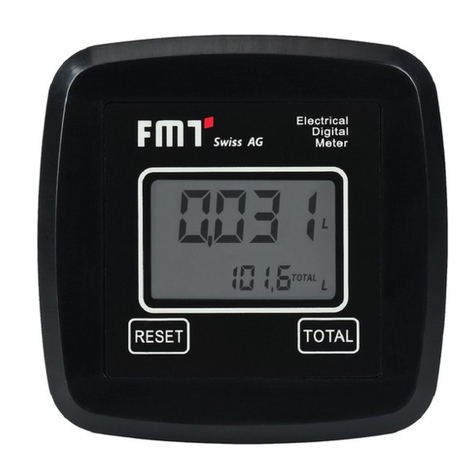
FMT Swiss AG
FMT Swiss AG 23 829 OPERATING INSTRUCTIONS AND SAFETY NOTES
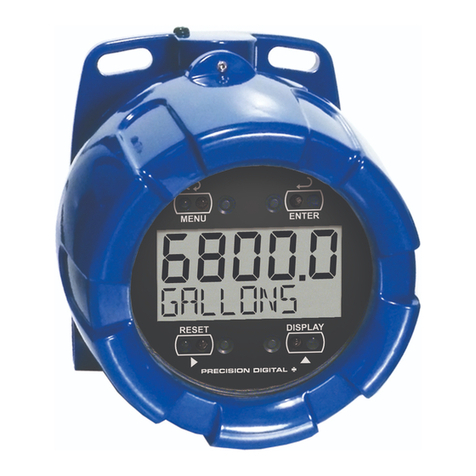
PRECISION DIGITAL
PRECISION DIGITAL ProtEx Pro PD6800-0L1 manual
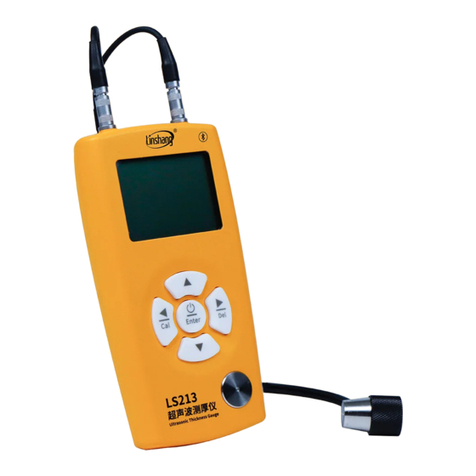
LINSHANG
LINSHANG LS213 user manual
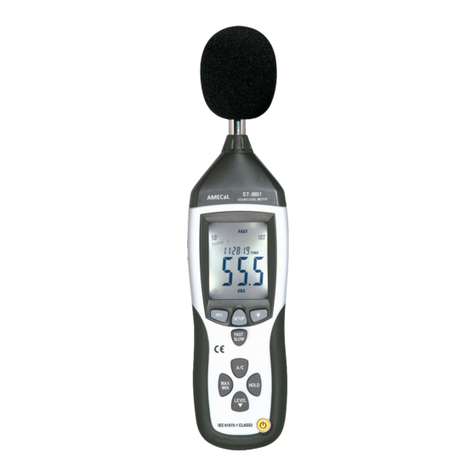
ATP Instrumentation
ATP Instrumentation SL-8851 manual
